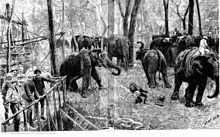George P. Sanderson

George Peress Sanderson was born in India in 1848, the son of Rev. Daniel Sanderson, who was a Methodist missionary in India from 1842 to 1867. George Sanderson was sent home for schooling to his father’s family in Cockermouth, Cumbria. He was at the Wesley (Methodist) Kingswood School, Bath, from 1859 to 1863, returning to India in 1864 at the age of 16.

During his employment in the irrigation department of Mysore with the British Government in India he found time for big game hunting which included tigers, elephants and the Indian Bison.[1] His work involved the maintenance of 150 miles of canals around Hunsur as Assistant Channel Superintendent. Over the years he rose to become head of the irrigation department and was in charge of 716 miles of canals that went through the forests. He encountered elephants and tigers during this period and saw that some roving herds were destructive and suggested that they be captured. In September 1875, he was put in temporary charge of an elephant catching team of Bengal and worked in the Garo and Chittagong hills. They captured 85 elephants before he returned to Mysore.[2] He introduced a novel way of catching wild elephants for subsequent taming and training in forestry work. Instead of trapping elephants in pits, he tried a method of driving herds into a kheddah, a fenced, ditched enclosure. This technique was a spectacular success and in 1889 he organised a demonstration to entertain Prince Albert, Duke of Clarence & Avondale, when he visited India. The press referred to Sanderson as the elephant (or hathee) king.[3][4][5]
Sanderson wrote a book, Thirteen Years Among the Wild Beasts of India, based to a large extent on his life at Morlay in the Biligirirangan Hills.[6] He died of pulmonary phthisis in Chennai in 1892 shortly after marriage and on the way back to a long leave in England.[4]
In an article published by the Kipling Society in 1971 it was suggested that "Petersen Sahib, the man who caught all the elephants for the Government of India" in the Jungle Book story, Toomai of the Elephants by Rudyard Kipling, was a reference to George Peress Sanderson.[7]
References
- ↑ Sanderson, G.P. (1879). Thirteen years among the wild beasts of India. London: W.H.Allen and Co. p. 3.
- ↑ Manchester Courier and Lancashire General Advertiser. 20 August 1892. p. 14 http://www.britishnewspaperarchive.co.uk/viewer/bl/0000206/18920820/122/0014 – via British Newspaper Archive. (subscription required (help)). Missing or empty
|title=(help) - ↑ Smith, A. Mervyn (1904). Sport and Adventure in the Indian Jungle. London: Hurst and Blackett. p. 1.
- ↑ 4.0 4.1 "Death of the Elephant King". Aberdeen Journal. 18 June 1892. p. 7. Retrieved 1 October 2014 – via British Newspaper Archive. (subscription required (help)).
- ↑ Ellison, Bernard C. (1925). H.R.H. The Prince of Wales's Sport in India. London: William Heinemann.
- ↑ Buel, J.W. (1887). Sea and Land. An Illustrated History. Toronto: J.S. Robertson & Brothers. pp. 545–551.
- ↑ Tasker, Sir Theodore (1971). "Petersen sahib". The Kipling Journal.
External links
|